Leading Change in Organizations: Unilever Case Study Report
VerifiedAdded on 2021/02/21
|12
|3790
|98
Report
AI Summary
This report examines the critical aspects of leading change within organizations, using Unilever as a primary case study. It begins by assessing the impact of change on an organization's strategy and operational procedures, highlighting the significance of adapting to evolving consumer preferences and technological advancements. The report then delves into both internal and external drivers of change, such as cultural shifts, structural adjustments, political, economic, and technological factors, and analyzes their effects on leadership, team dynamics, and individual behaviors. Furthermore, it provides actionable measures to mitigate the negative impacts of change on organizational behavior, emphasizing the importance of aligning changes with business goals, assessing their impacts, fostering effective communication, providing comprehensive training, and integrating changes seamlessly into the organization. The report also addresses barriers to change and their influence on leadership decision-making, concluding with a discussion of various leadership approaches to effectively navigate and manage change within an organizational context.
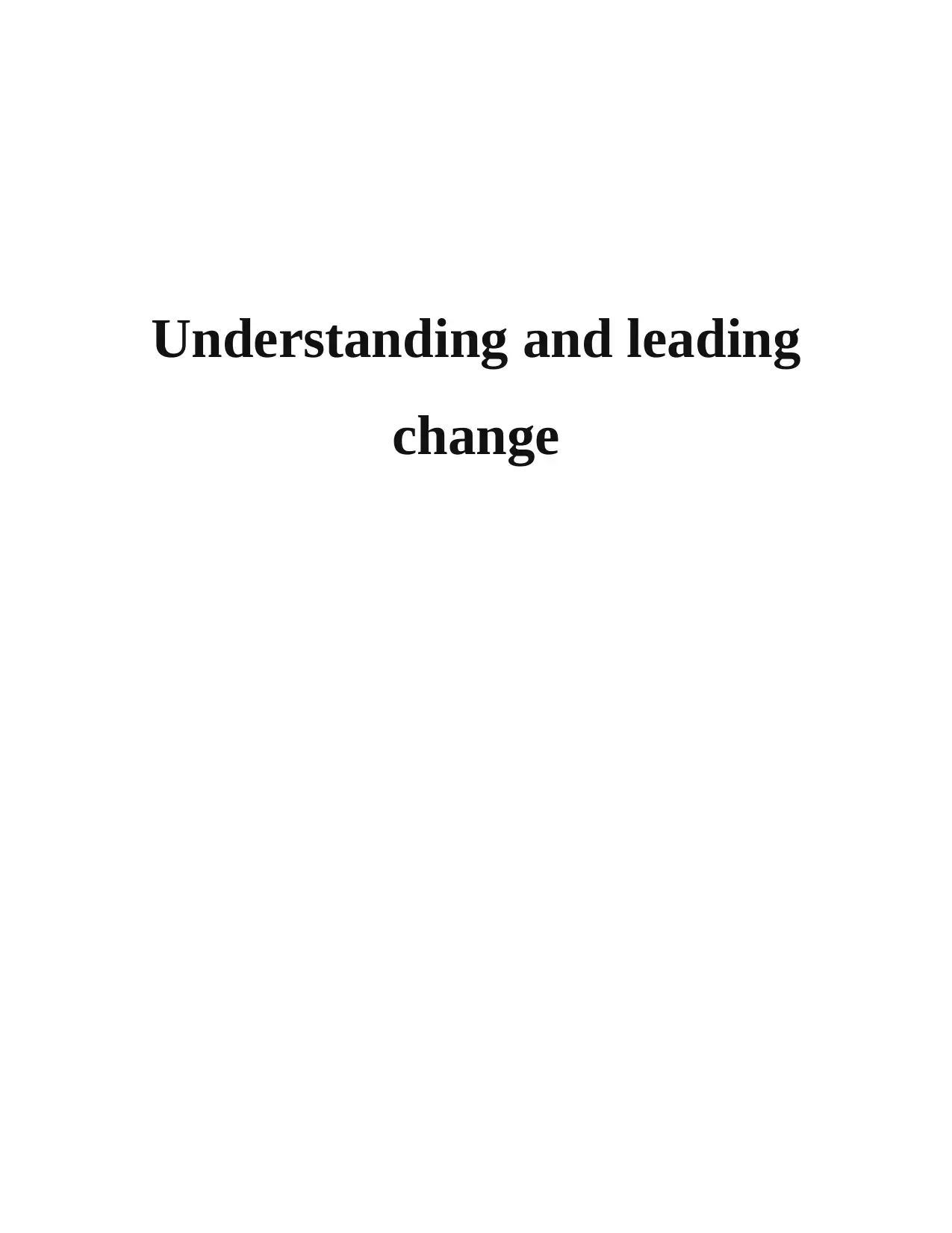
Understanding and leading
change
change
Paraphrase This Document
Need a fresh take? Get an instant paraphrase of this document with our AI Paraphraser
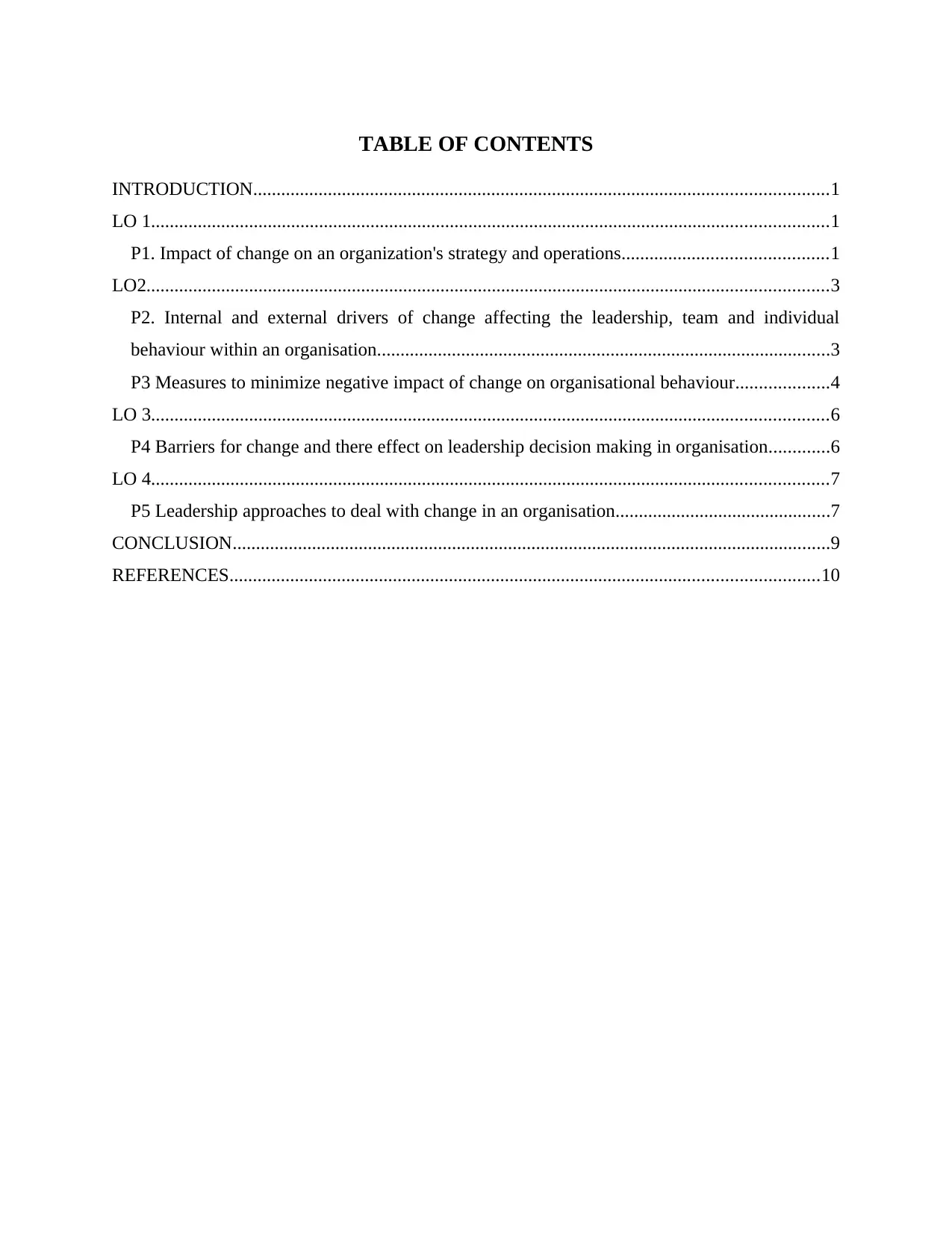
TABLE OF CONTENTS
INTRODUCTION...........................................................................................................................1
LO 1.................................................................................................................................................1
P1. Impact of change on an organization's strategy and operations............................................1
LO2..................................................................................................................................................3
P2. Internal and external drivers of change affecting the leadership, team and individual
behaviour within an organisation.................................................................................................3
P3 Measures to minimize negative impact of change on organisational behaviour....................4
LO 3.................................................................................................................................................6
P4 Barriers for change and there effect on leadership decision making in organisation.............6
LO 4.................................................................................................................................................7
P5 Leadership approaches to deal with change in an organisation..............................................7
CONCLUSION................................................................................................................................9
REFERENCES..............................................................................................................................10
INTRODUCTION...........................................................................................................................1
LO 1.................................................................................................................................................1
P1. Impact of change on an organization's strategy and operations............................................1
LO2..................................................................................................................................................3
P2. Internal and external drivers of change affecting the leadership, team and individual
behaviour within an organisation.................................................................................................3
P3 Measures to minimize negative impact of change on organisational behaviour....................4
LO 3.................................................................................................................................................6
P4 Barriers for change and there effect on leadership decision making in organisation.............6
LO 4.................................................................................................................................................7
P5 Leadership approaches to deal with change in an organisation..............................................7
CONCLUSION................................................................................................................................9
REFERENCES..............................................................................................................................10
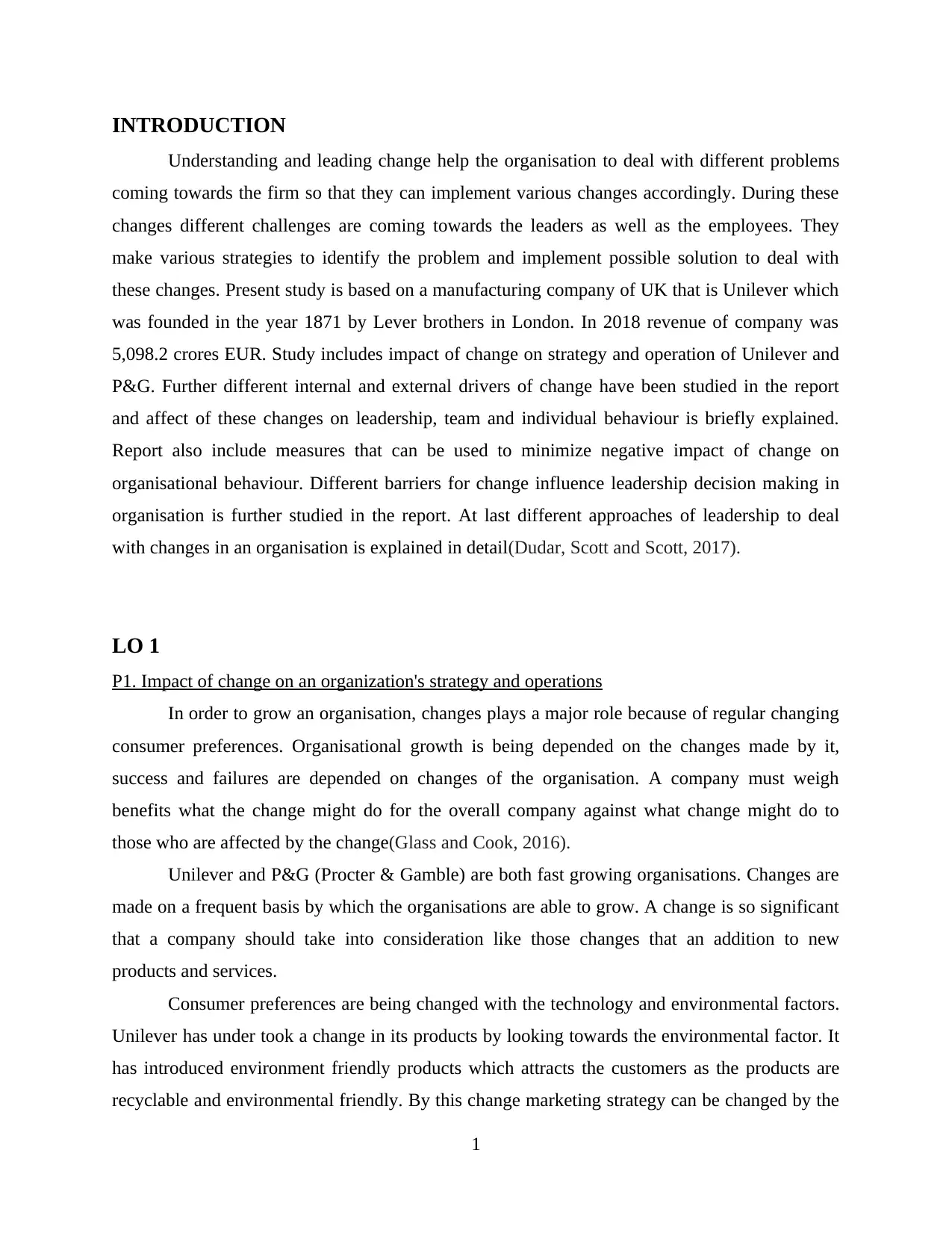
INTRODUCTION
Understanding and leading change help the organisation to deal with different problems
coming towards the firm so that they can implement various changes accordingly. During these
changes different challenges are coming towards the leaders as well as the employees. They
make various strategies to identify the problem and implement possible solution to deal with
these changes. Present study is based on a manufacturing company of UK that is Unilever which
was founded in the year 1871 by Lever brothers in London. In 2018 revenue of company was
5,098.2 crores EUR. Study includes impact of change on strategy and operation of Unilever and
P&G. Further different internal and external drivers of change have been studied in the report
and affect of these changes on leadership, team and individual behaviour is briefly explained.
Report also include measures that can be used to minimize negative impact of change on
organisational behaviour. Different barriers for change influence leadership decision making in
organisation is further studied in the report. At last different approaches of leadership to deal
with changes in an organisation is explained in detail(Dudar, Scott and Scott, 2017).
LO 1
P1. Impact of change on an organization's strategy and operations
In order to grow an organisation, changes plays a major role because of regular changing
consumer preferences. Organisational growth is being depended on the changes made by it,
success and failures are depended on changes of the organisation. A company must weigh
benefits what the change might do for the overall company against what change might do to
those who are affected by the change(Glass and Cook, 2016).
Unilever and P&G (Procter & Gamble) are both fast growing organisations. Changes are
made on a frequent basis by which the organisations are able to grow. A change is so significant
that a company should take into consideration like those changes that an addition to new
products and services.
Consumer preferences are being changed with the technology and environmental factors.
Unilever has under took a change in its products by looking towards the environmental factor. It
has introduced environment friendly products which attracts the customers as the products are
recyclable and environmental friendly. By this change marketing strategy can be changed by the
1
Understanding and leading change help the organisation to deal with different problems
coming towards the firm so that they can implement various changes accordingly. During these
changes different challenges are coming towards the leaders as well as the employees. They
make various strategies to identify the problem and implement possible solution to deal with
these changes. Present study is based on a manufacturing company of UK that is Unilever which
was founded in the year 1871 by Lever brothers in London. In 2018 revenue of company was
5,098.2 crores EUR. Study includes impact of change on strategy and operation of Unilever and
P&G. Further different internal and external drivers of change have been studied in the report
and affect of these changes on leadership, team and individual behaviour is briefly explained.
Report also include measures that can be used to minimize negative impact of change on
organisational behaviour. Different barriers for change influence leadership decision making in
organisation is further studied in the report. At last different approaches of leadership to deal
with changes in an organisation is explained in detail(Dudar, Scott and Scott, 2017).
LO 1
P1. Impact of change on an organization's strategy and operations
In order to grow an organisation, changes plays a major role because of regular changing
consumer preferences. Organisational growth is being depended on the changes made by it,
success and failures are depended on changes of the organisation. A company must weigh
benefits what the change might do for the overall company against what change might do to
those who are affected by the change(Glass and Cook, 2016).
Unilever and P&G (Procter & Gamble) are both fast growing organisations. Changes are
made on a frequent basis by which the organisations are able to grow. A change is so significant
that a company should take into consideration like those changes that an addition to new
products and services.
Consumer preferences are being changed with the technology and environmental factors.
Unilever has under took a change in its products by looking towards the environmental factor. It
has introduced environment friendly products which attracts the customers as the products are
recyclable and environmental friendly. By this change marketing strategy can be changed by the
1
⊘ This is a preview!⊘
Do you want full access?
Subscribe today to unlock all pages.

Trusted by 1+ million students worldwide
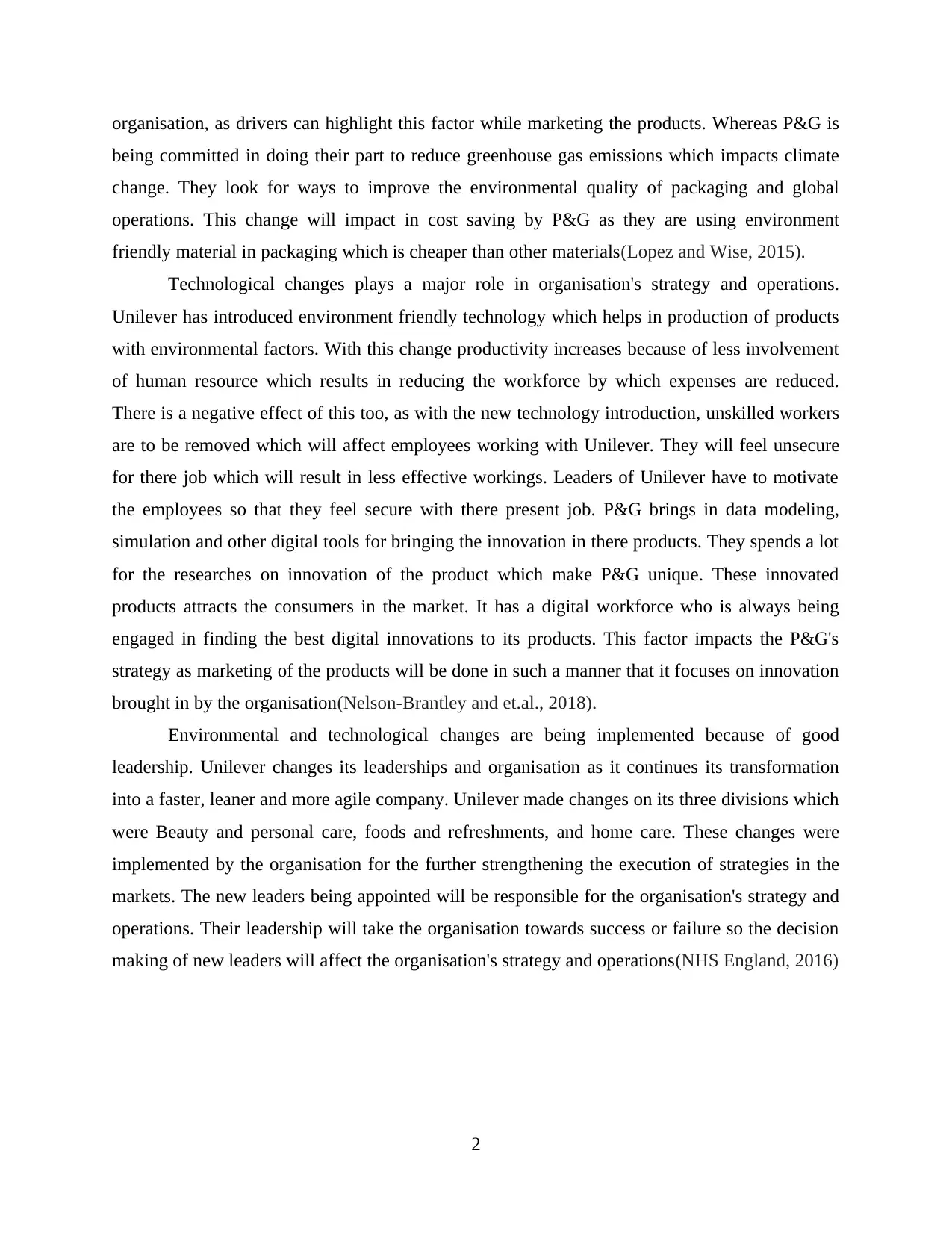
organisation, as drivers can highlight this factor while marketing the products. Whereas P&G is
being committed in doing their part to reduce greenhouse gas emissions which impacts climate
change. They look for ways to improve the environmental quality of packaging and global
operations. This change will impact in cost saving by P&G as they are using environment
friendly material in packaging which is cheaper than other materials(Lopez and Wise, 2015).
Technological changes plays a major role in organisation's strategy and operations.
Unilever has introduced environment friendly technology which helps in production of products
with environmental factors. With this change productivity increases because of less involvement
of human resource which results in reducing the workforce by which expenses are reduced.
There is a negative effect of this too, as with the new technology introduction, unskilled workers
are to be removed which will affect employees working with Unilever. They will feel unsecure
for there job which will result in less effective workings. Leaders of Unilever have to motivate
the employees so that they feel secure with there present job. P&G brings in data modeling,
simulation and other digital tools for bringing the innovation in there products. They spends a lot
for the researches on innovation of the product which make P&G unique. These innovated
products attracts the consumers in the market. It has a digital workforce who is always being
engaged in finding the best digital innovations to its products. This factor impacts the P&G's
strategy as marketing of the products will be done in such a manner that it focuses on innovation
brought in by the organisation(Nelson-Brantley and et.al., 2018).
Environmental and technological changes are being implemented because of good
leadership. Unilever changes its leaderships and organisation as it continues its transformation
into a faster, leaner and more agile company. Unilever made changes on its three divisions which
were Beauty and personal care, foods and refreshments, and home care. These changes were
implemented by the organisation for the further strengthening the execution of strategies in the
markets. The new leaders being appointed will be responsible for the organisation's strategy and
operations. Their leadership will take the organisation towards success or failure so the decision
making of new leaders will affect the organisation's strategy and operations(NHS England, 2016)
2
being committed in doing their part to reduce greenhouse gas emissions which impacts climate
change. They look for ways to improve the environmental quality of packaging and global
operations. This change will impact in cost saving by P&G as they are using environment
friendly material in packaging which is cheaper than other materials(Lopez and Wise, 2015).
Technological changes plays a major role in organisation's strategy and operations.
Unilever has introduced environment friendly technology which helps in production of products
with environmental factors. With this change productivity increases because of less involvement
of human resource which results in reducing the workforce by which expenses are reduced.
There is a negative effect of this too, as with the new technology introduction, unskilled workers
are to be removed which will affect employees working with Unilever. They will feel unsecure
for there job which will result in less effective workings. Leaders of Unilever have to motivate
the employees so that they feel secure with there present job. P&G brings in data modeling,
simulation and other digital tools for bringing the innovation in there products. They spends a lot
for the researches on innovation of the product which make P&G unique. These innovated
products attracts the consumers in the market. It has a digital workforce who is always being
engaged in finding the best digital innovations to its products. This factor impacts the P&G's
strategy as marketing of the products will be done in such a manner that it focuses on innovation
brought in by the organisation(Nelson-Brantley and et.al., 2018).
Environmental and technological changes are being implemented because of good
leadership. Unilever changes its leaderships and organisation as it continues its transformation
into a faster, leaner and more agile company. Unilever made changes on its three divisions which
were Beauty and personal care, foods and refreshments, and home care. These changes were
implemented by the organisation for the further strengthening the execution of strategies in the
markets. The new leaders being appointed will be responsible for the organisation's strategy and
operations. Their leadership will take the organisation towards success or failure so the decision
making of new leaders will affect the organisation's strategy and operations(NHS England, 2016)
2
Paraphrase This Document
Need a fresh take? Get an instant paraphrase of this document with our AI Paraphraser
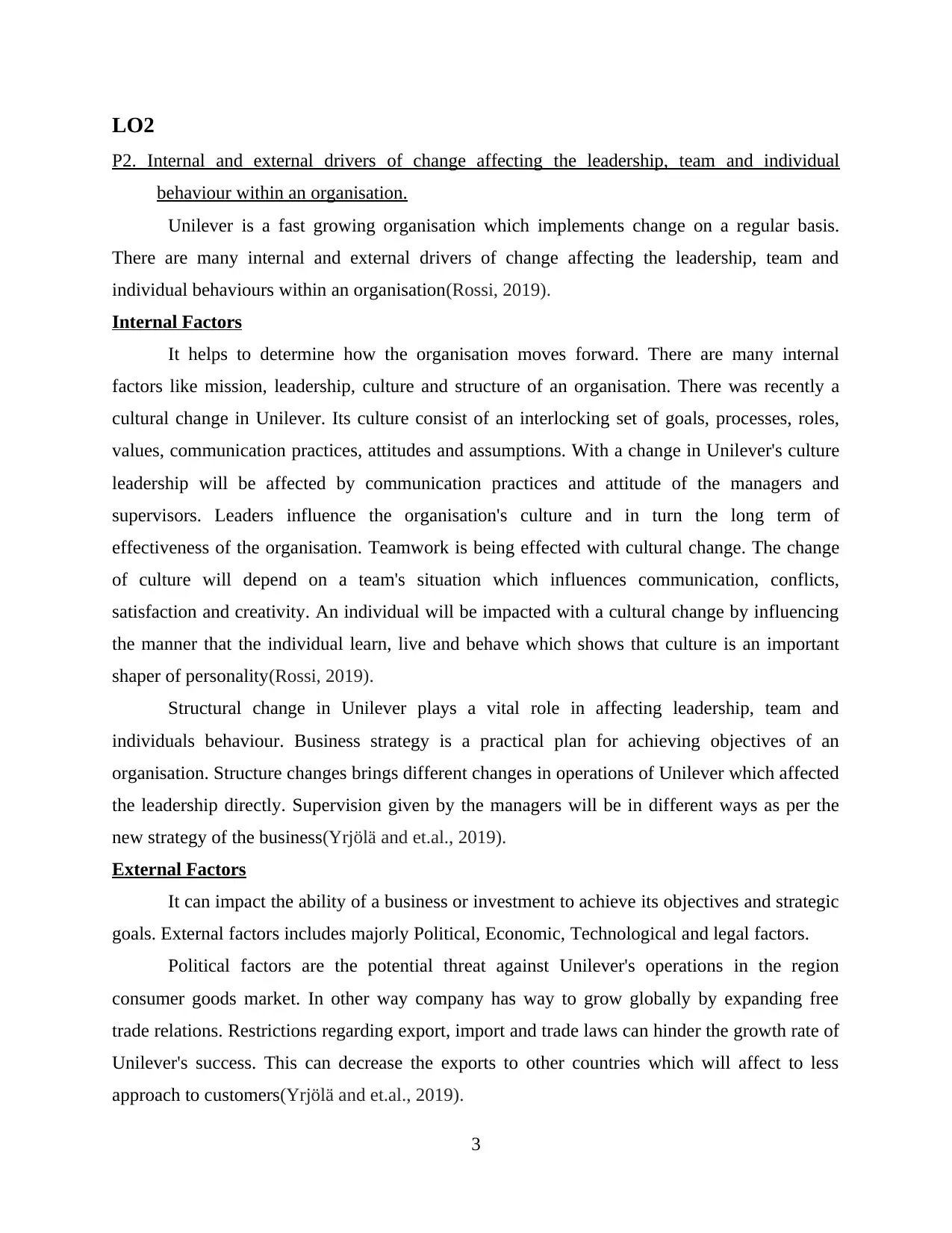
LO2
P2. Internal and external drivers of change affecting the leadership, team and individual
behaviour within an organisation.
Unilever is a fast growing organisation which implements change on a regular basis.
There are many internal and external drivers of change affecting the leadership, team and
individual behaviours within an organisation(Rossi, 2019).
Internal Factors
It helps to determine how the organisation moves forward. There are many internal
factors like mission, leadership, culture and structure of an organisation. There was recently a
cultural change in Unilever. Its culture consist of an interlocking set of goals, processes, roles,
values, communication practices, attitudes and assumptions. With a change in Unilever's culture
leadership will be affected by communication practices and attitude of the managers and
supervisors. Leaders influence the organisation's culture and in turn the long term of
effectiveness of the organisation. Teamwork is being effected with cultural change. The change
of culture will depend on a team's situation which influences communication, conflicts,
satisfaction and creativity. An individual will be impacted with a cultural change by influencing
the manner that the individual learn, live and behave which shows that culture is an important
shaper of personality(Rossi, 2019).
Structural change in Unilever plays a vital role in affecting leadership, team and
individuals behaviour. Business strategy is a practical plan for achieving objectives of an
organisation. Structure changes brings different changes in operations of Unilever which affected
the leadership directly. Supervision given by the managers will be in different ways as per the
new strategy of the business(Yrjölä and et.al., 2019).
External Factors
It can impact the ability of a business or investment to achieve its objectives and strategic
goals. External factors includes majorly Political, Economic, Technological and legal factors.
Political factors are the potential threat against Unilever's operations in the region
consumer goods market. In other way company has way to grow globally by expanding free
trade relations. Restrictions regarding export, import and trade laws can hinder the growth rate of
Unilever's success. This can decrease the exports to other countries which will affect to less
approach to customers(Yrjölä and et.al., 2019).
3
P2. Internal and external drivers of change affecting the leadership, team and individual
behaviour within an organisation.
Unilever is a fast growing organisation which implements change on a regular basis.
There are many internal and external drivers of change affecting the leadership, team and
individual behaviours within an organisation(Rossi, 2019).
Internal Factors
It helps to determine how the organisation moves forward. There are many internal
factors like mission, leadership, culture and structure of an organisation. There was recently a
cultural change in Unilever. Its culture consist of an interlocking set of goals, processes, roles,
values, communication practices, attitudes and assumptions. With a change in Unilever's culture
leadership will be affected by communication practices and attitude of the managers and
supervisors. Leaders influence the organisation's culture and in turn the long term of
effectiveness of the organisation. Teamwork is being effected with cultural change. The change
of culture will depend on a team's situation which influences communication, conflicts,
satisfaction and creativity. An individual will be impacted with a cultural change by influencing
the manner that the individual learn, live and behave which shows that culture is an important
shaper of personality(Rossi, 2019).
Structural change in Unilever plays a vital role in affecting leadership, team and
individuals behaviour. Business strategy is a practical plan for achieving objectives of an
organisation. Structure changes brings different changes in operations of Unilever which affected
the leadership directly. Supervision given by the managers will be in different ways as per the
new strategy of the business(Yrjölä and et.al., 2019).
External Factors
It can impact the ability of a business or investment to achieve its objectives and strategic
goals. External factors includes majorly Political, Economic, Technological and legal factors.
Political factors are the potential threat against Unilever's operations in the region
consumer goods market. In other way company has way to grow globally by expanding free
trade relations. Restrictions regarding export, import and trade laws can hinder the growth rate of
Unilever's success. This can decrease the exports to other countries which will affect to less
approach to customers(Yrjölä and et.al., 2019).
3
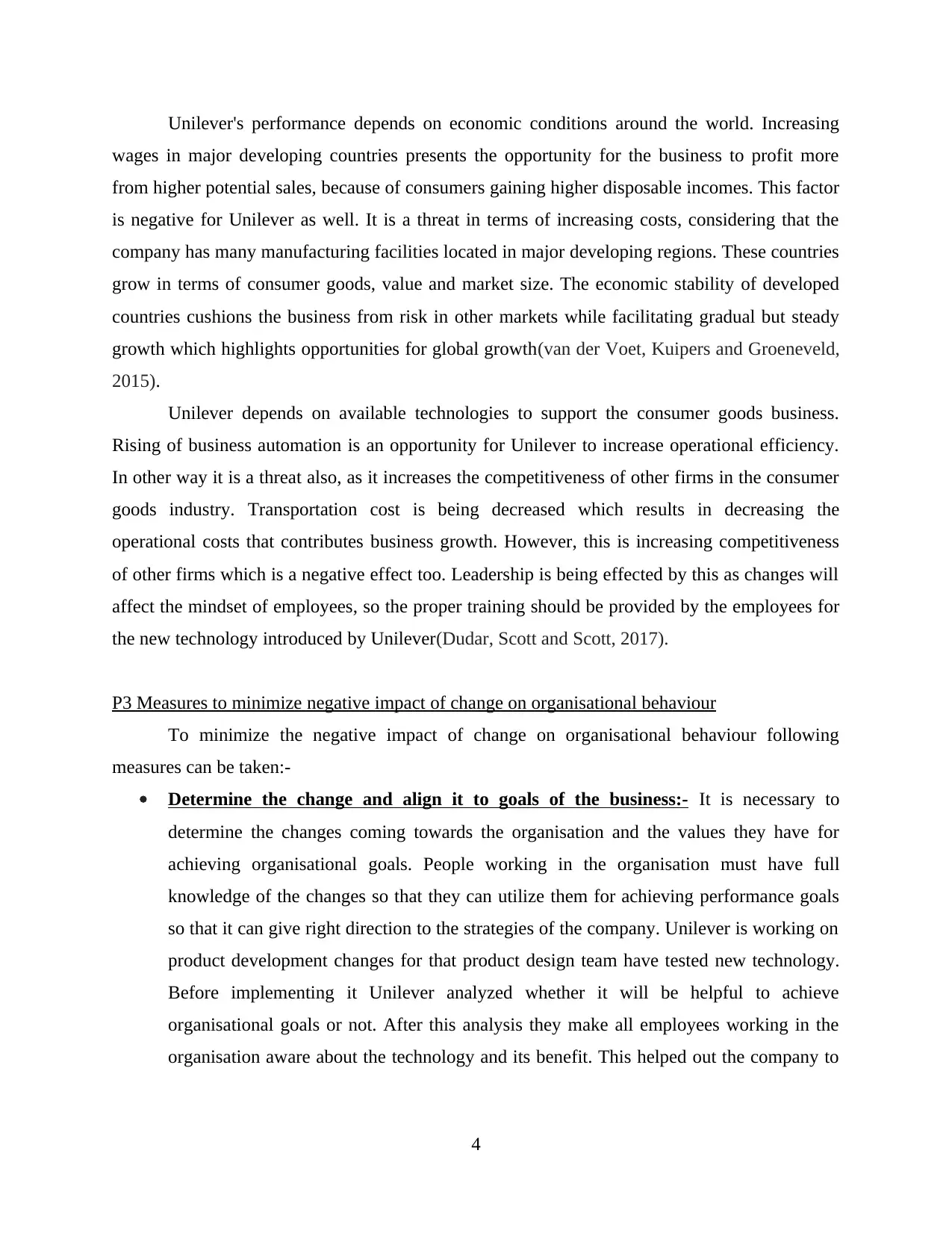
Unilever's performance depends on economic conditions around the world. Increasing
wages in major developing countries presents the opportunity for the business to profit more
from higher potential sales, because of consumers gaining higher disposable incomes. This factor
is negative for Unilever as well. It is a threat in terms of increasing costs, considering that the
company has many manufacturing facilities located in major developing regions. These countries
grow in terms of consumer goods, value and market size. The economic stability of developed
countries cushions the business from risk in other markets while facilitating gradual but steady
growth which highlights opportunities for global growth(van der Voet, Kuipers and Groeneveld,
2015).
Unilever depends on available technologies to support the consumer goods business.
Rising of business automation is an opportunity for Unilever to increase operational efficiency.
In other way it is a threat also, as it increases the competitiveness of other firms in the consumer
goods industry. Transportation cost is being decreased which results in decreasing the
operational costs that contributes business growth. However, this is increasing competitiveness
of other firms which is a negative effect too. Leadership is being effected by this as changes will
affect the mindset of employees, so the proper training should be provided by the employees for
the new technology introduced by Unilever(Dudar, Scott and Scott, 2017).
P3 Measures to minimize negative impact of change on organisational behaviour
To minimize the negative impact of change on organisational behaviour following
measures can be taken:-
Determine the change and align it to goals of the business:- It is necessary to
determine the changes coming towards the organisation and the values they have for
achieving organisational goals. People working in the organisation must have full
knowledge of the changes so that they can utilize them for achieving performance goals
so that it can give right direction to the strategies of the company. Unilever is working on
product development changes for that product design team have tested new technology.
Before implementing it Unilever analyzed whether it will be helpful to achieve
organisational goals or not. After this analysis they make all employees working in the
organisation aware about the technology and its benefit. This helped out the company to
4
wages in major developing countries presents the opportunity for the business to profit more
from higher potential sales, because of consumers gaining higher disposable incomes. This factor
is negative for Unilever as well. It is a threat in terms of increasing costs, considering that the
company has many manufacturing facilities located in major developing regions. These countries
grow in terms of consumer goods, value and market size. The economic stability of developed
countries cushions the business from risk in other markets while facilitating gradual but steady
growth which highlights opportunities for global growth(van der Voet, Kuipers and Groeneveld,
2015).
Unilever depends on available technologies to support the consumer goods business.
Rising of business automation is an opportunity for Unilever to increase operational efficiency.
In other way it is a threat also, as it increases the competitiveness of other firms in the consumer
goods industry. Transportation cost is being decreased which results in decreasing the
operational costs that contributes business growth. However, this is increasing competitiveness
of other firms which is a negative effect too. Leadership is being effected by this as changes will
affect the mindset of employees, so the proper training should be provided by the employees for
the new technology introduced by Unilever(Dudar, Scott and Scott, 2017).
P3 Measures to minimize negative impact of change on organisational behaviour
To minimize the negative impact of change on organisational behaviour following
measures can be taken:-
Determine the change and align it to goals of the business:- It is necessary to
determine the changes coming towards the organisation and the values they have for
achieving organisational goals. People working in the organisation must have full
knowledge of the changes so that they can utilize them for achieving performance goals
so that it can give right direction to the strategies of the company. Unilever is working on
product development changes for that product design team have tested new technology.
Before implementing it Unilever analyzed whether it will be helpful to achieve
organisational goals or not. After this analysis they make all employees working in the
organisation aware about the technology and its benefit. This helped out the company to
4
⊘ This is a preview!⊘
Do you want full access?
Subscribe today to unlock all pages.

Trusted by 1+ million students worldwide
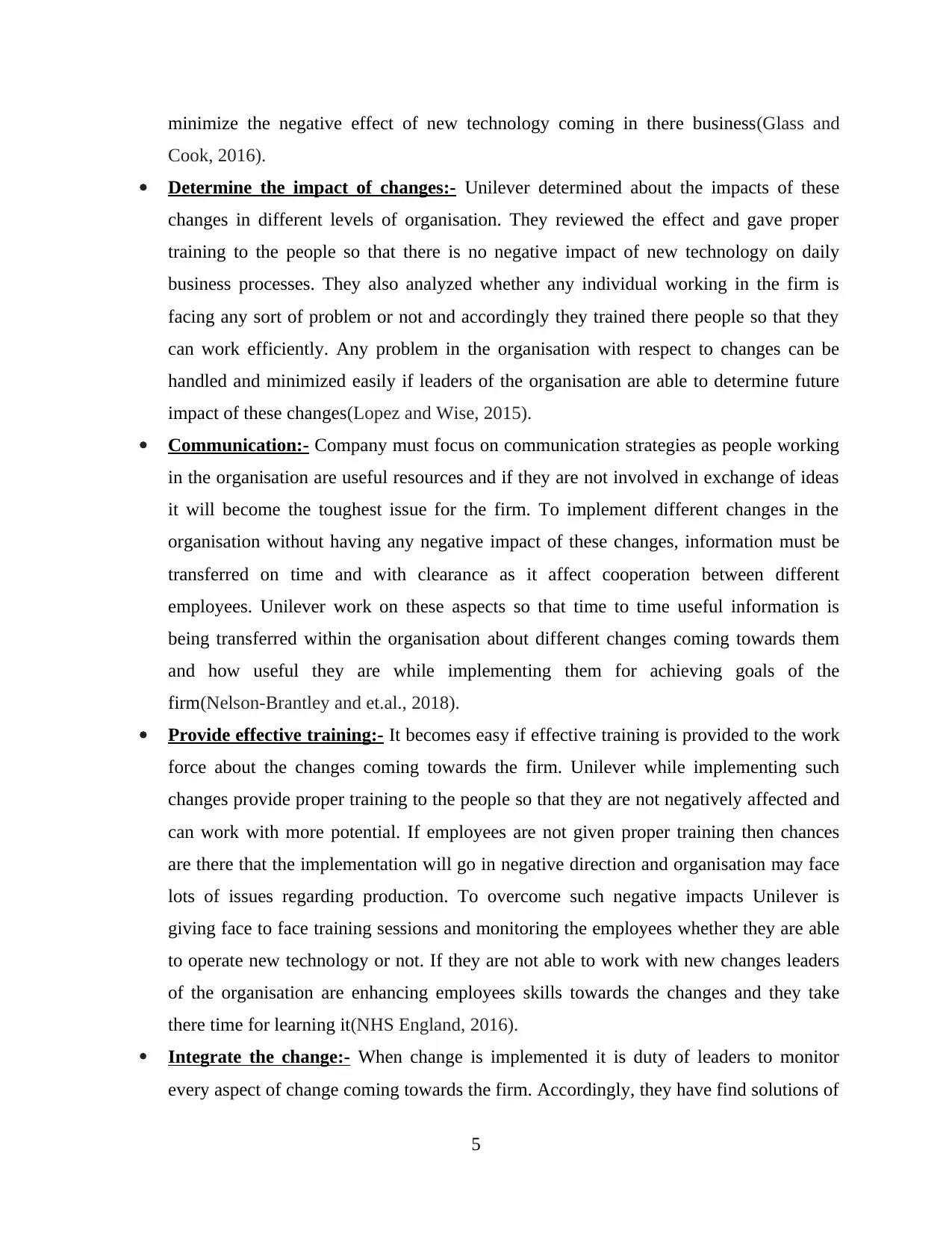
minimize the negative effect of new technology coming in there business(Glass and
Cook, 2016).
Determine the impact of changes:- Unilever determined about the impacts of these
changes in different levels of organisation. They reviewed the effect and gave proper
training to the people so that there is no negative impact of new technology on daily
business processes. They also analyzed whether any individual working in the firm is
facing any sort of problem or not and accordingly they trained there people so that they
can work efficiently. Any problem in the organisation with respect to changes can be
handled and minimized easily if leaders of the organisation are able to determine future
impact of these changes(Lopez and Wise, 2015).
Communication:- Company must focus on communication strategies as people working
in the organisation are useful resources and if they are not involved in exchange of ideas
it will become the toughest issue for the firm. To implement different changes in the
organisation without having any negative impact of these changes, information must be
transferred on time and with clearance as it affect cooperation between different
employees. Unilever work on these aspects so that time to time useful information is
being transferred within the organisation about different changes coming towards them
and how useful they are while implementing them for achieving goals of the
firm(Nelson-Brantley and et.al., 2018).
Provide effective training:- It becomes easy if effective training is provided to the work
force about the changes coming towards the firm. Unilever while implementing such
changes provide proper training to the people so that they are not negatively affected and
can work with more potential. If employees are not given proper training then chances
are there that the implementation will go in negative direction and organisation may face
lots of issues regarding production. To overcome such negative impacts Unilever is
giving face to face training sessions and monitoring the employees whether they are able
to operate new technology or not. If they are not able to work with new changes leaders
of the organisation are enhancing employees skills towards the changes and they take
there time for learning it(NHS England, 2016).
Integrate the change:- When change is implemented it is duty of leaders to monitor
every aspect of change coming towards the firm. Accordingly, they have find solutions of
5
Cook, 2016).
Determine the impact of changes:- Unilever determined about the impacts of these
changes in different levels of organisation. They reviewed the effect and gave proper
training to the people so that there is no negative impact of new technology on daily
business processes. They also analyzed whether any individual working in the firm is
facing any sort of problem or not and accordingly they trained there people so that they
can work efficiently. Any problem in the organisation with respect to changes can be
handled and minimized easily if leaders of the organisation are able to determine future
impact of these changes(Lopez and Wise, 2015).
Communication:- Company must focus on communication strategies as people working
in the organisation are useful resources and if they are not involved in exchange of ideas
it will become the toughest issue for the firm. To implement different changes in the
organisation without having any negative impact of these changes, information must be
transferred on time and with clearance as it affect cooperation between different
employees. Unilever work on these aspects so that time to time useful information is
being transferred within the organisation about different changes coming towards them
and how useful they are while implementing them for achieving goals of the
firm(Nelson-Brantley and et.al., 2018).
Provide effective training:- It becomes easy if effective training is provided to the work
force about the changes coming towards the firm. Unilever while implementing such
changes provide proper training to the people so that they are not negatively affected and
can work with more potential. If employees are not given proper training then chances
are there that the implementation will go in negative direction and organisation may face
lots of issues regarding production. To overcome such negative impacts Unilever is
giving face to face training sessions and monitoring the employees whether they are able
to operate new technology or not. If they are not able to work with new changes leaders
of the organisation are enhancing employees skills towards the changes and they take
there time for learning it(NHS England, 2016).
Integrate the change:- When change is implemented it is duty of leaders to monitor
every aspect of change coming towards the firm. Accordingly, they have find solutions of
5
Paraphrase This Document
Need a fresh take? Get an instant paraphrase of this document with our AI Paraphraser
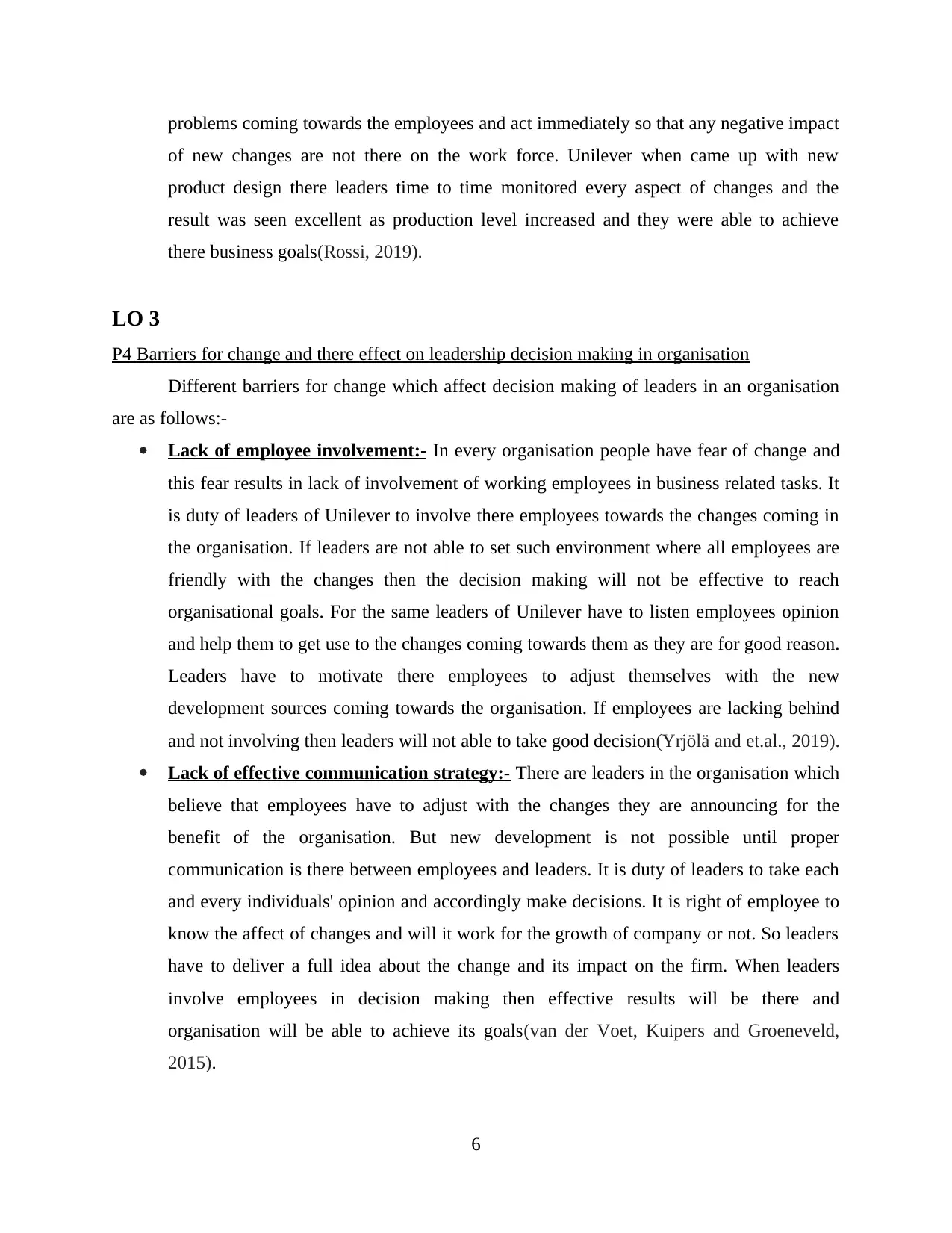
problems coming towards the employees and act immediately so that any negative impact
of new changes are not there on the work force. Unilever when came up with new
product design there leaders time to time monitored every aspect of changes and the
result was seen excellent as production level increased and they were able to achieve
there business goals(Rossi, 2019).
LO 3
P4 Barriers for change and there effect on leadership decision making in organisation
Different barriers for change which affect decision making of leaders in an organisation
are as follows:-
Lack of employee involvement:- In every organisation people have fear of change and
this fear results in lack of involvement of working employees in business related tasks. It
is duty of leaders of Unilever to involve there employees towards the changes coming in
the organisation. If leaders are not able to set such environment where all employees are
friendly with the changes then the decision making will not be effective to reach
organisational goals. For the same leaders of Unilever have to listen employees opinion
and help them to get use to the changes coming towards them as they are for good reason.
Leaders have to motivate there employees to adjust themselves with the new
development sources coming towards the organisation. If employees are lacking behind
and not involving then leaders will not able to take good decision(Yrjölä and et.al., 2019).
Lack of effective communication strategy:- There are leaders in the organisation which
believe that employees have to adjust with the changes they are announcing for the
benefit of the organisation. But new development is not possible until proper
communication is there between employees and leaders. It is duty of leaders to take each
and every individuals' opinion and accordingly make decisions. It is right of employee to
know the affect of changes and will it work for the growth of company or not. So leaders
have to deliver a full idea about the change and its impact on the firm. When leaders
involve employees in decision making then effective results will be there and
organisation will be able to achieve its goals(van der Voet, Kuipers and Groeneveld,
2015).
6
of new changes are not there on the work force. Unilever when came up with new
product design there leaders time to time monitored every aspect of changes and the
result was seen excellent as production level increased and they were able to achieve
there business goals(Rossi, 2019).
LO 3
P4 Barriers for change and there effect on leadership decision making in organisation
Different barriers for change which affect decision making of leaders in an organisation
are as follows:-
Lack of employee involvement:- In every organisation people have fear of change and
this fear results in lack of involvement of working employees in business related tasks. It
is duty of leaders of Unilever to involve there employees towards the changes coming in
the organisation. If leaders are not able to set such environment where all employees are
friendly with the changes then the decision making will not be effective to reach
organisational goals. For the same leaders of Unilever have to listen employees opinion
and help them to get use to the changes coming towards them as they are for good reason.
Leaders have to motivate there employees to adjust themselves with the new
development sources coming towards the organisation. If employees are lacking behind
and not involving then leaders will not able to take good decision(Yrjölä and et.al., 2019).
Lack of effective communication strategy:- There are leaders in the organisation which
believe that employees have to adjust with the changes they are announcing for the
benefit of the organisation. But new development is not possible until proper
communication is there between employees and leaders. It is duty of leaders to take each
and every individuals' opinion and accordingly make decisions. It is right of employee to
know the affect of changes and will it work for the growth of company or not. So leaders
have to deliver a full idea about the change and its impact on the firm. When leaders
involve employees in decision making then effective results will be there and
organisation will be able to achieve its goals(van der Voet, Kuipers and Groeneveld,
2015).
6
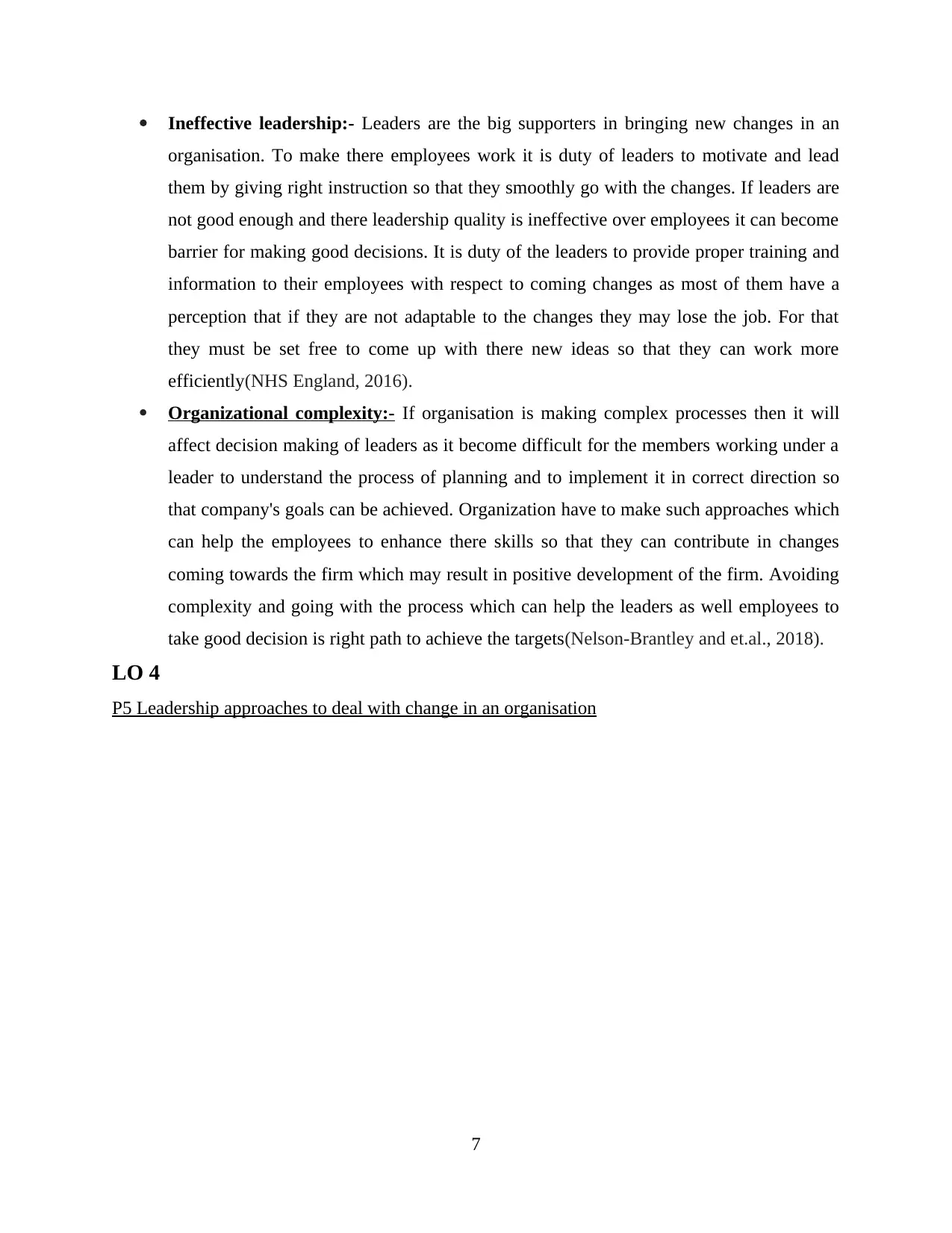
Ineffective leadership:- Leaders are the big supporters in bringing new changes in an
organisation. To make there employees work it is duty of leaders to motivate and lead
them by giving right instruction so that they smoothly go with the changes. If leaders are
not good enough and there leadership quality is ineffective over employees it can become
barrier for making good decisions. It is duty of the leaders to provide proper training and
information to their employees with respect to coming changes as most of them have a
perception that if they are not adaptable to the changes they may lose the job. For that
they must be set free to come up with there new ideas so that they can work more
efficiently(NHS England, 2016).
Organizational complexity:- If organisation is making complex processes then it will
affect decision making of leaders as it become difficult for the members working under a
leader to understand the process of planning and to implement it in correct direction so
that company's goals can be achieved. Organization have to make such approaches which
can help the employees to enhance there skills so that they can contribute in changes
coming towards the firm which may result in positive development of the firm. Avoiding
complexity and going with the process which can help the leaders as well employees to
take good decision is right path to achieve the targets(Nelson-Brantley and et.al., 2018).
LO 4
P5 Leadership approaches to deal with change in an organisation
7
organisation. To make there employees work it is duty of leaders to motivate and lead
them by giving right instruction so that they smoothly go with the changes. If leaders are
not good enough and there leadership quality is ineffective over employees it can become
barrier for making good decisions. It is duty of the leaders to provide proper training and
information to their employees with respect to coming changes as most of them have a
perception that if they are not adaptable to the changes they may lose the job. For that
they must be set free to come up with there new ideas so that they can work more
efficiently(NHS England, 2016).
Organizational complexity:- If organisation is making complex processes then it will
affect decision making of leaders as it become difficult for the members working under a
leader to understand the process of planning and to implement it in correct direction so
that company's goals can be achieved. Organization have to make such approaches which
can help the employees to enhance there skills so that they can contribute in changes
coming towards the firm which may result in positive development of the firm. Avoiding
complexity and going with the process which can help the leaders as well employees to
take good decision is right path to achieve the targets(Nelson-Brantley and et.al., 2018).
LO 4
P5 Leadership approaches to deal with change in an organisation
7
⊘ This is a preview!⊘
Do you want full access?
Subscribe today to unlock all pages.

Trusted by 1+ million students worldwide
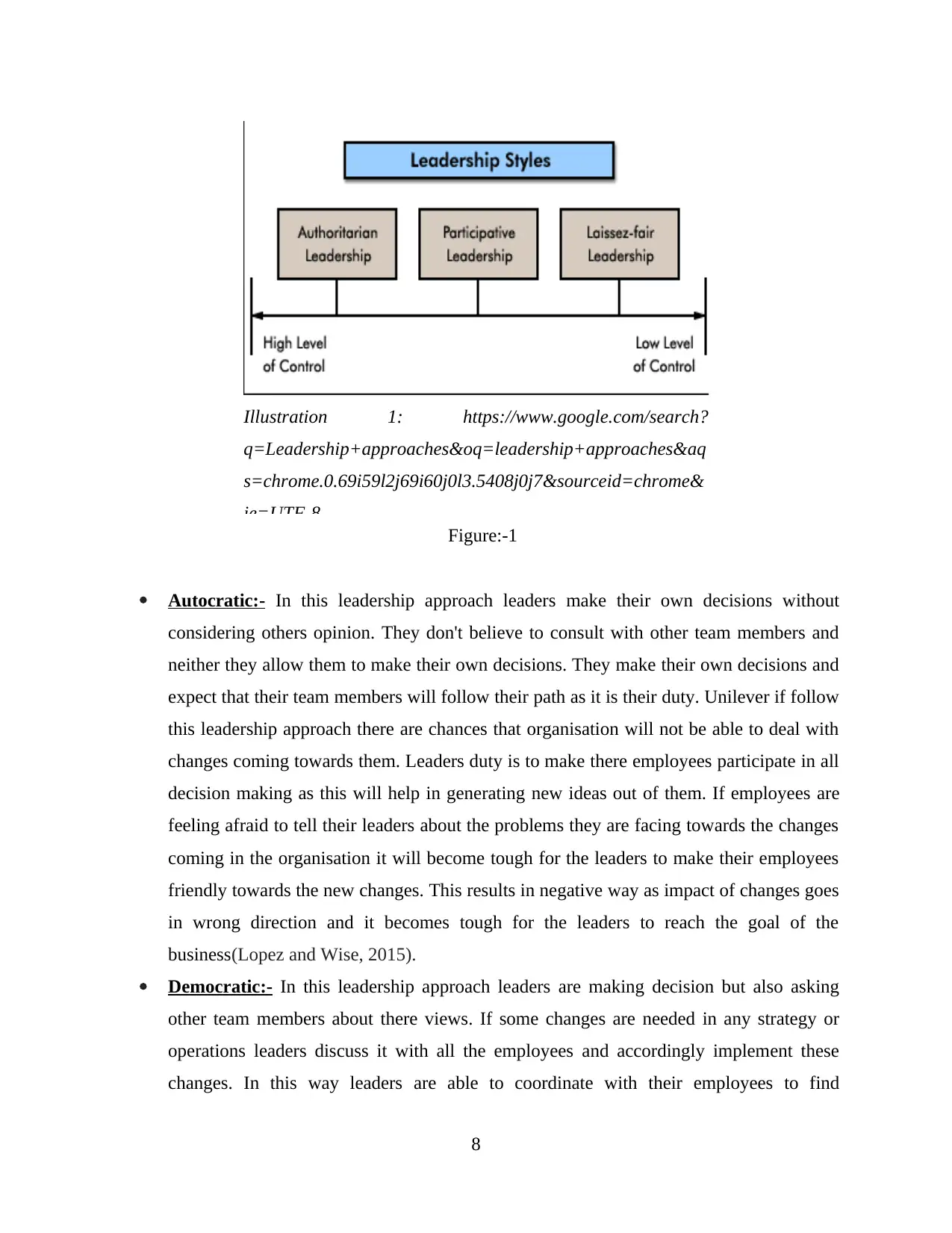
Figure:-1
Autocratic:- In this leadership approach leaders make their own decisions without
considering others opinion. They don't believe to consult with other team members and
neither they allow them to make their own decisions. They make their own decisions and
expect that their team members will follow their path as it is their duty. Unilever if follow
this leadership approach there are chances that organisation will not be able to deal with
changes coming towards them. Leaders duty is to make there employees participate in all
decision making as this will help in generating new ideas out of them. If employees are
feeling afraid to tell their leaders about the problems they are facing towards the changes
coming in the organisation it will become tough for the leaders to make their employees
friendly towards the new changes. This results in negative way as impact of changes goes
in wrong direction and it becomes tough for the leaders to reach the goal of the
business(Lopez and Wise, 2015).
Democratic:- In this leadership approach leaders are making decision but also asking
other team members about there views. If some changes are needed in any strategy or
operations leaders discuss it with all the employees and accordingly implement these
changes. In this way leaders are able to coordinate with their employees to find
8
Illustration 1: https://www.google.com/search?
q=Leadership+approaches&oq=leadership+approaches&aq
s=chrome.0.69i59l2j69i60j0l3.5408j0j7&sourceid=chrome&
ie=UTF-8
Autocratic:- In this leadership approach leaders make their own decisions without
considering others opinion. They don't believe to consult with other team members and
neither they allow them to make their own decisions. They make their own decisions and
expect that their team members will follow their path as it is their duty. Unilever if follow
this leadership approach there are chances that organisation will not be able to deal with
changes coming towards them. Leaders duty is to make there employees participate in all
decision making as this will help in generating new ideas out of them. If employees are
feeling afraid to tell their leaders about the problems they are facing towards the changes
coming in the organisation it will become tough for the leaders to make their employees
friendly towards the new changes. This results in negative way as impact of changes goes
in wrong direction and it becomes tough for the leaders to reach the goal of the
business(Lopez and Wise, 2015).
Democratic:- In this leadership approach leaders are making decision but also asking
other team members about there views. If some changes are needed in any strategy or
operations leaders discuss it with all the employees and accordingly implement these
changes. In this way leaders are able to coordinate with their employees to find
8
Illustration 1: https://www.google.com/search?
q=Leadership+approaches&oq=leadership+approaches&aq
s=chrome.0.69i59l2j69i60j0l3.5408j0j7&sourceid=chrome&
ie=UTF-8
Paraphrase This Document
Need a fresh take? Get an instant paraphrase of this document with our AI Paraphraser
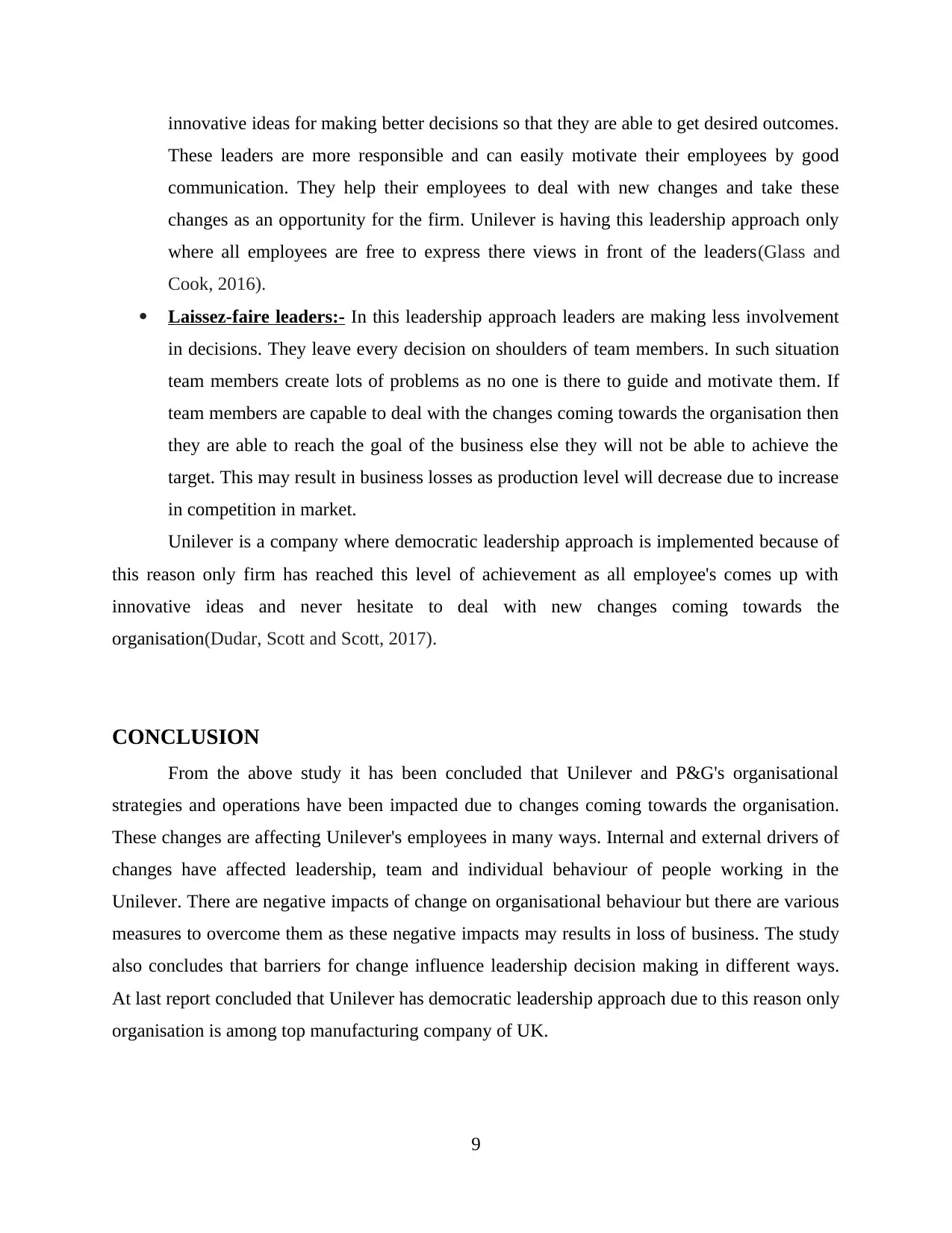
innovative ideas for making better decisions so that they are able to get desired outcomes.
These leaders are more responsible and can easily motivate their employees by good
communication. They help their employees to deal with new changes and take these
changes as an opportunity for the firm. Unilever is having this leadership approach only
where all employees are free to express there views in front of the leaders(Glass and
Cook, 2016).
Laissez-faire leaders:- In this leadership approach leaders are making less involvement
in decisions. They leave every decision on shoulders of team members. In such situation
team members create lots of problems as no one is there to guide and motivate them. If
team members are capable to deal with the changes coming towards the organisation then
they are able to reach the goal of the business else they will not be able to achieve the
target. This may result in business losses as production level will decrease due to increase
in competition in market.
Unilever is a company where democratic leadership approach is implemented because of
this reason only firm has reached this level of achievement as all employee's comes up with
innovative ideas and never hesitate to deal with new changes coming towards the
organisation(Dudar, Scott and Scott, 2017).
CONCLUSION
From the above study it has been concluded that Unilever and P&G's organisational
strategies and operations have been impacted due to changes coming towards the organisation.
These changes are affecting Unilever's employees in many ways. Internal and external drivers of
changes have affected leadership, team and individual behaviour of people working in the
Unilever. There are negative impacts of change on organisational behaviour but there are various
measures to overcome them as these negative impacts may results in loss of business. The study
also concludes that barriers for change influence leadership decision making in different ways.
At last report concluded that Unilever has democratic leadership approach due to this reason only
organisation is among top manufacturing company of UK.
9
These leaders are more responsible and can easily motivate their employees by good
communication. They help their employees to deal with new changes and take these
changes as an opportunity for the firm. Unilever is having this leadership approach only
where all employees are free to express there views in front of the leaders(Glass and
Cook, 2016).
Laissez-faire leaders:- In this leadership approach leaders are making less involvement
in decisions. They leave every decision on shoulders of team members. In such situation
team members create lots of problems as no one is there to guide and motivate them. If
team members are capable to deal with the changes coming towards the organisation then
they are able to reach the goal of the business else they will not be able to achieve the
target. This may result in business losses as production level will decrease due to increase
in competition in market.
Unilever is a company where democratic leadership approach is implemented because of
this reason only firm has reached this level of achievement as all employee's comes up with
innovative ideas and never hesitate to deal with new changes coming towards the
organisation(Dudar, Scott and Scott, 2017).
CONCLUSION
From the above study it has been concluded that Unilever and P&G's organisational
strategies and operations have been impacted due to changes coming towards the organisation.
These changes are affecting Unilever's employees in many ways. Internal and external drivers of
changes have affected leadership, team and individual behaviour of people working in the
Unilever. There are negative impacts of change on organisational behaviour but there are various
measures to overcome them as these negative impacts may results in loss of business. The study
also concludes that barriers for change influence leadership decision making in different ways.
At last report concluded that Unilever has democratic leadership approach due to this reason only
organisation is among top manufacturing company of UK.
9
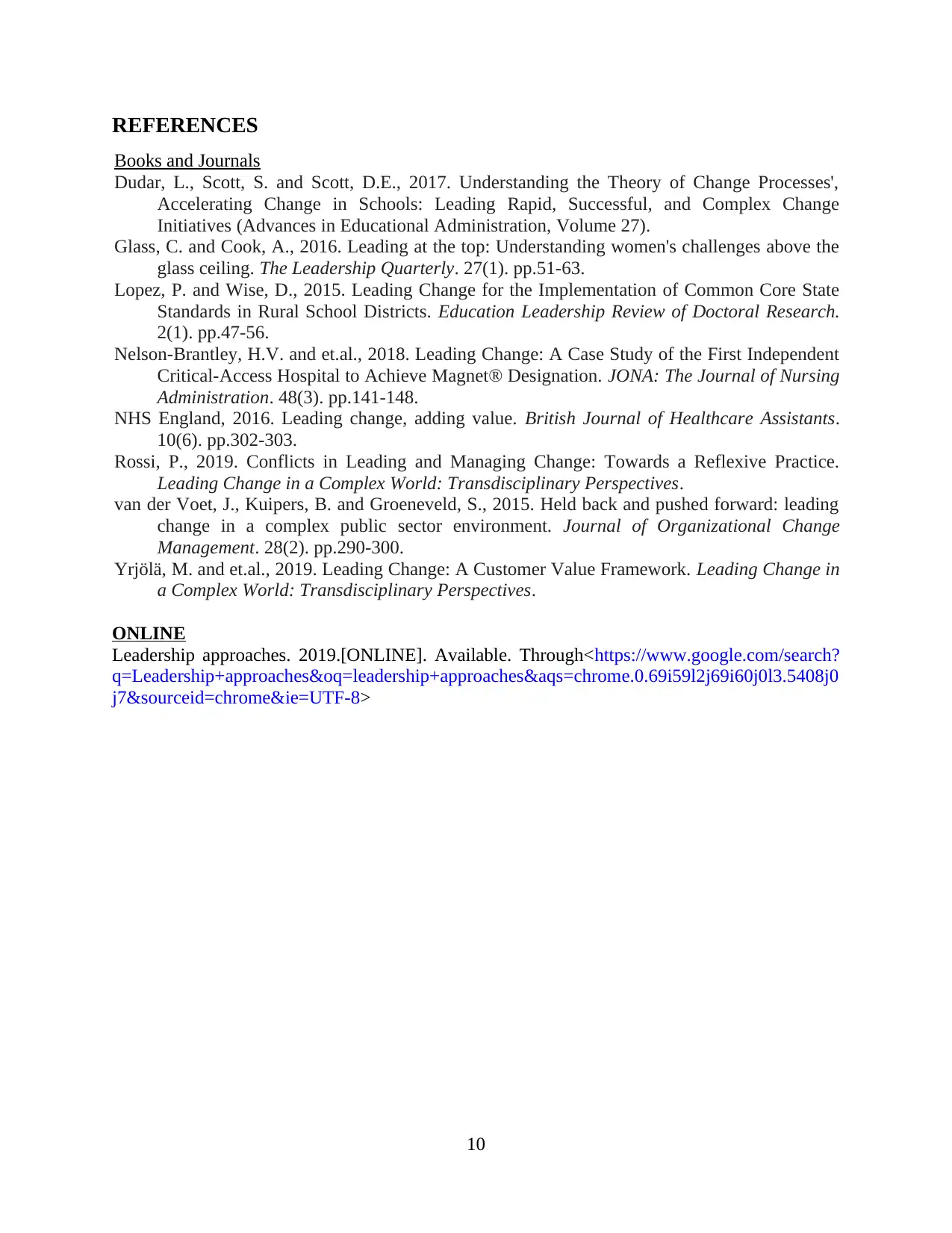
REFERENCES
Books and Journals
Dudar, L., Scott, S. and Scott, D.E., 2017. Understanding the Theory of Change Processes',
Accelerating Change in Schools: Leading Rapid, Successful, and Complex Change
Initiatives (Advances in Educational Administration, Volume 27).
Glass, C. and Cook, A., 2016. Leading at the top: Understanding women's challenges above the
glass ceiling. The Leadership Quarterly. 27(1). pp.51-63.
Lopez, P. and Wise, D., 2015. Leading Change for the Implementation of Common Core State
Standards in Rural School Districts. Education Leadership Review of Doctoral Research.
2(1). pp.47-56.
Nelson-Brantley, H.V. and et.al., 2018. Leading Change: A Case Study of the First Independent
Critical-Access Hospital to Achieve Magnet® Designation. JONA: The Journal of Nursing
Administration. 48(3). pp.141-148.
NHS England, 2016. Leading change, adding value. British Journal of Healthcare Assistants.
10(6). pp.302-303.
Rossi, P., 2019. Conflicts in Leading and Managing Change: Towards a Reflexive Practice.
Leading Change in a Complex World: Transdisciplinary Perspectives.
van der Voet, J., Kuipers, B. and Groeneveld, S., 2015. Held back and pushed forward: leading
change in a complex public sector environment. Journal of Organizational Change
Management. 28(2). pp.290-300.
Yrjölä, M. and et.al., 2019. Leading Change: A Customer Value Framework. Leading Change in
a Complex World: Transdisciplinary Perspectives.
ONLINE
Leadership approaches. 2019.[ONLINE]. Available. Through<https://www.google.com/search?
q=Leadership+approaches&oq=leadership+approaches&aqs=chrome.0.69i59l2j69i60j0l3.5408j0
j7&sourceid=chrome&ie=UTF-8>
10
Books and Journals
Dudar, L., Scott, S. and Scott, D.E., 2017. Understanding the Theory of Change Processes',
Accelerating Change in Schools: Leading Rapid, Successful, and Complex Change
Initiatives (Advances in Educational Administration, Volume 27).
Glass, C. and Cook, A., 2016. Leading at the top: Understanding women's challenges above the
glass ceiling. The Leadership Quarterly. 27(1). pp.51-63.
Lopez, P. and Wise, D., 2015. Leading Change for the Implementation of Common Core State
Standards in Rural School Districts. Education Leadership Review of Doctoral Research.
2(1). pp.47-56.
Nelson-Brantley, H.V. and et.al., 2018. Leading Change: A Case Study of the First Independent
Critical-Access Hospital to Achieve Magnet® Designation. JONA: The Journal of Nursing
Administration. 48(3). pp.141-148.
NHS England, 2016. Leading change, adding value. British Journal of Healthcare Assistants.
10(6). pp.302-303.
Rossi, P., 2019. Conflicts in Leading and Managing Change: Towards a Reflexive Practice.
Leading Change in a Complex World: Transdisciplinary Perspectives.
van der Voet, J., Kuipers, B. and Groeneveld, S., 2015. Held back and pushed forward: leading
change in a complex public sector environment. Journal of Organizational Change
Management. 28(2). pp.290-300.
Yrjölä, M. and et.al., 2019. Leading Change: A Customer Value Framework. Leading Change in
a Complex World: Transdisciplinary Perspectives.
ONLINE
Leadership approaches. 2019.[ONLINE]. Available. Through<https://www.google.com/search?
q=Leadership+approaches&oq=leadership+approaches&aqs=chrome.0.69i59l2j69i60j0l3.5408j0
j7&sourceid=chrome&ie=UTF-8>
10
⊘ This is a preview!⊘
Do you want full access?
Subscribe today to unlock all pages.

Trusted by 1+ million students worldwide
1 out of 12
Related Documents
Your All-in-One AI-Powered Toolkit for Academic Success.
+13062052269
info@desklib.com
Available 24*7 on WhatsApp / Email
![[object Object]](/_next/static/media/star-bottom.7253800d.svg)
Unlock your academic potential
Copyright © 2020–2025 A2Z Services. All Rights Reserved. Developed and managed by ZUCOL.





